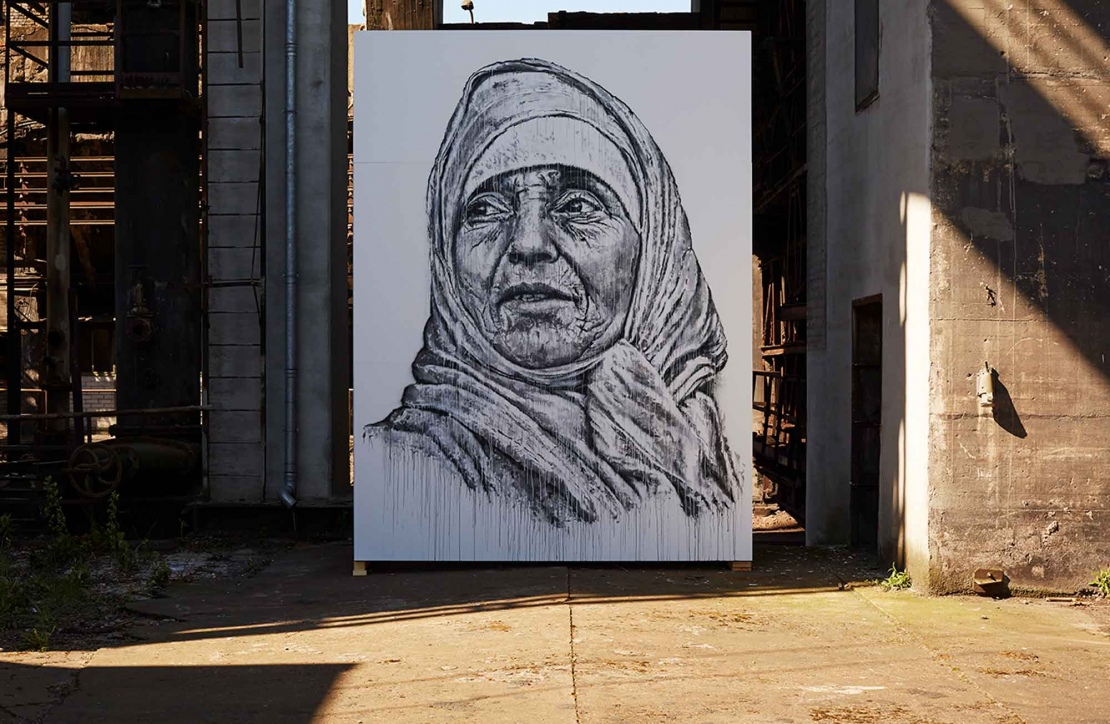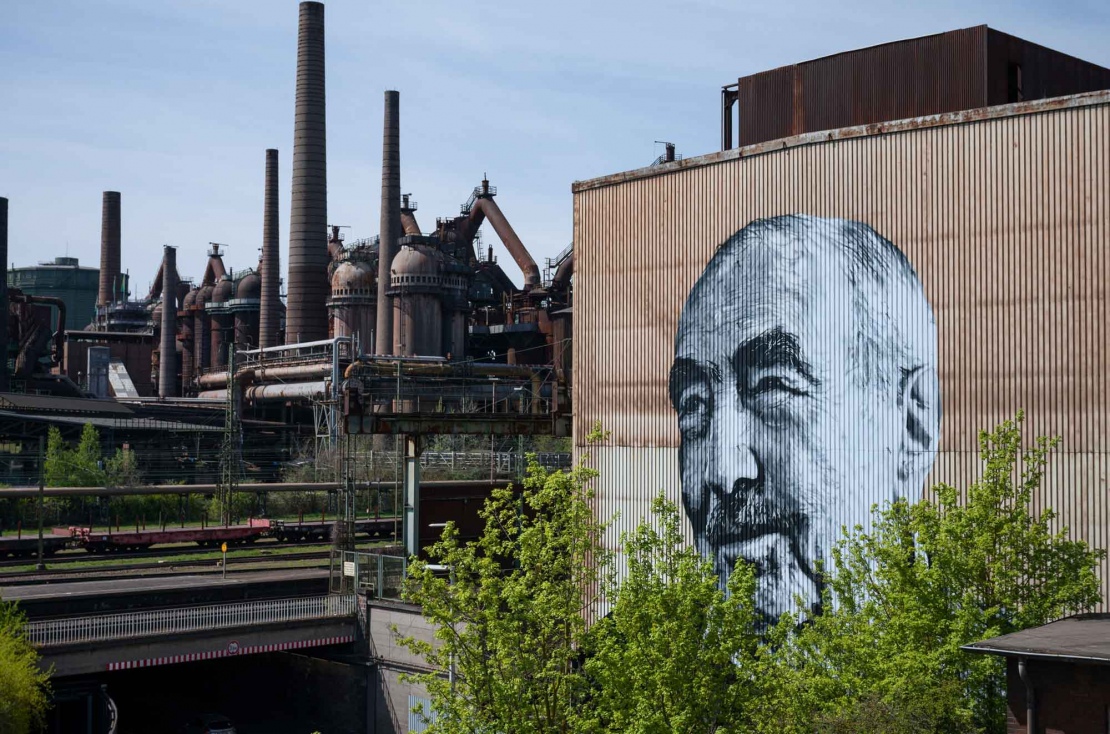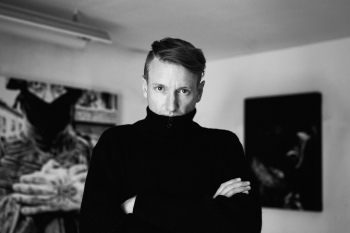Hendrik Beikirch
Website: www.ecbwork.de
Exhibitions
Works
Rakouch Timallizene

Beikirch R T
Copyright: Weltkulturerbe Völklinger Hütte / Hans-Georg Merkel
Date
2015, in situ
Dimensions
4 x 3 m
Material
Acryl, Sprühfarbe, Holz
Description
In his project Tracing Morocco, which Hendrik Beikirch initiated in 2014, the artist portrays people encountered during his numerous visits to the Maghreb. Fascinated by the diversity of Morocco, as well as by the pride and joie de vivre of the country's inhabitants in the face of the oft-harsh living conditions, Beikirch set himself the goal of recording the special aura of the people he has met on the roads of the remote interior and in the mountain villages. With his portraits, he preserves the memory of the people and the handicrafts they practice, which are based on a wealth of knowledge that has been passed down for generations—but which, in this modern world, could soon all be a thing of the past. Beikirch initially produced his portraits in conventional format on canvas during an artist residency at Jardin Rouge, near Marrakech. In 2015, however, he began to render them on urban walls all over the world. And thus Beikirch's tribute to the traditional potter Rakouch Timallizene, who in all probability would have otherwise remained nameless and faceless, is now to be seen at the World Heritage Site Völklingen Ironworks.
Daniel Bauer
Kaya Urhan

Beikirch Kaya
Copyright: Weltkulturere Völklinger Hütte / Oliver Dietze
Date
2022, in situ
Dimensions
20 x 20 m
Material
Acrylfarbe
Description
Hendrik Beikirch painted a 600 square metre portrait of the former smelter worker Kaya Urhan on the metal cladding of the former Saarstahl continuous casting plant on Rathausstraße. Beikirch, who as a graffiti artist is one of the most important European pioneers in the development of today's urban mural painting, has long focussed on monumental monochrome portraits of real people. Kaya Urhan, portrayed here, came to Völklingen from Turkey in 1971 and witnessed the last tapping at Blast Furnace III in 1986. Even as a pensioner, he has always remained an avowed Völklinger. With the structural change, he became a contemporary witness of the Völklingen Ironworks. He filmed one of the last working days of pig iron production in 1986 himself. The World Heritage Site is now able to present this unique document online from the authentic perspective of the workers on site. "The special character of a region is always created by the lives and actions of those who spend their lives there," says Hendrik Beikirch. With his portrait, he is helping to ensure that this is not so easily overlooked.
Robert Kaltenhäuser
Kaya Urhan

Beikirch Kaya
Copyright: Weltkulturere Völklinger Hütte / Oliver Dietze
Date
2022, in situ
Dimensions
20 x 20 m
Material
Acrylic paint
Description
Auf die Metallverkleidung der ehemaligen Stranggussanlage von Saarstahl an der Rathausstraße malte Hendrik Beikirch das gut 600 qm große Porträt des früheren Hüttenarbeiters Kaya Urhan. Beikirch, der als Graffiti-Künstler zu den wichtigsten europäischen Pionieren in der Entwicklung zur heutigen urbanen Wandmalerei gehört, konzentriert sich seit längerem auf monumentale monochrome Porträts realer Menschen. Der hier porträtierte Kaya Urhan kam 1971 aus der Türkei nach Völklingen und erlebte 1986 den letzten Abstich am Hochofen III. Auch als Rentner ist er immer bekennender Völklinger geblieben. Mit dem Strukturwandel wurde er zum Zeitzeugen der Völklinger Hütte. Einen der letzten Arbeitstage bei der Roheisenerzeugung 1986 hat er selbst gefilmt. So kann das Weltkulturerbe dieses einzigartige Dokument aus der authentischen Perspektive der Arbeiter vor Ort heute online präsentieren. „Das Besondere einer Region wird immer durch das Leben und Handeln derer, die darin ihr Leben verbringen, geschaffen“, so Hendrik Beikirch. Mit seinem Porträt trägt er dazu bei, dass dies niemand so leicht übersieht.
Rakouch Timallizene

Beikirch R T
Copyright: Weltkulturerbe Völklinger Hütte / Hans-Georg Merkel
Date
2015, in situ
Dimensions
4 x 3 m
Material
Acrylic paint, spray paint, wood
Description
In his project Tracing Morocco, which Hendrik Beikirch initiated in 2014, the artist portrays people encountered during his numerous visits to the Maghreb. Fascinated by the diversity of Morocco, as well as by the pride and joie de vivre of the country's inhabitants in the face of the oft-harsh living conditions, Beikirch set himself the goal of recording the special aura of the people he has met on the roads of the remote interior and in the mountain villages. With his portraits, he preserves the memory of the people and the handicrafts they practice, which are based on a wealth of knowledge that has been passed down for generations—but which, in this modern world, could soon all be a thing of the past. Beikirch initially produced his portraits in conventional format on canvas during an artist residency at Jardin Rouge, near Marrakech. In 2015, however, he began to render them on urban walls all over the world. And thus Beikirch's tribute to the traditional potter Rakouch Timallizene, who in all probability would have otherwise remained nameless and faceless, is now to be seen at the World Heritage Site Völklingen Ironworks.
